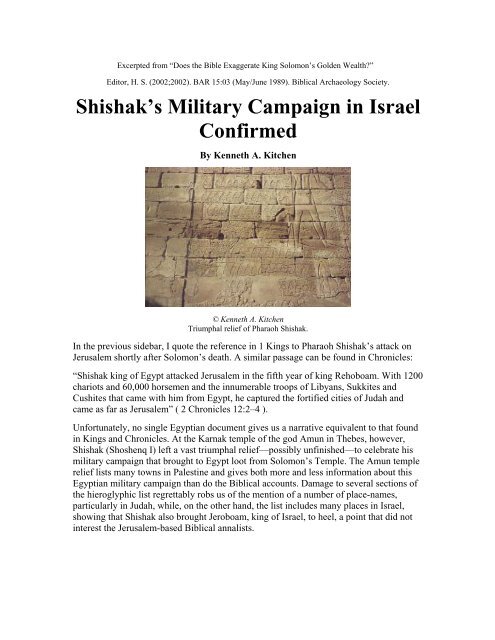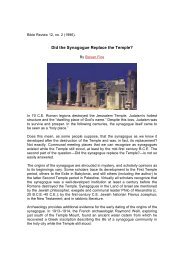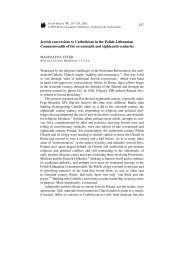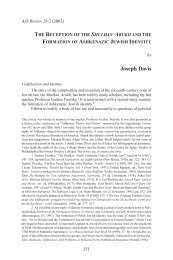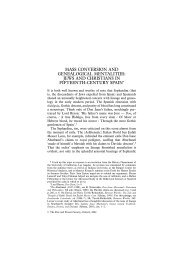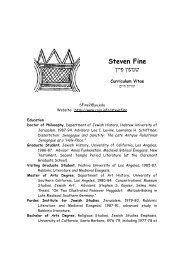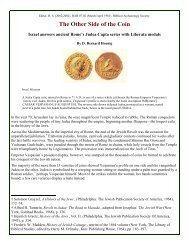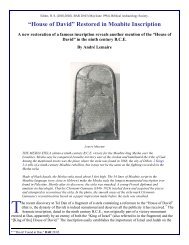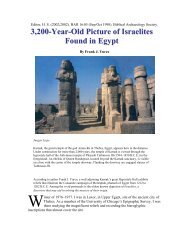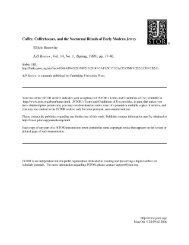Shishak's Military Campaign in Israel Confirmed
Shishak's Military Campaign in Israel Confirmed
Shishak's Military Campaign in Israel Confirmed
You also want an ePaper? Increase the reach of your titles
YUMPU automatically turns print PDFs into web optimized ePapers that Google loves.
Excerpted from “Does the Bible Exaggerate K<strong>in</strong>g Solomon’s Golden Wealth?”<br />
Editor, H. S. (2002;2002). BAR 15:03 (May/June 1989). Biblical Archaeology Society.<br />
Shishak’s <strong>Military</strong> <strong>Campaign</strong> <strong>in</strong> <strong>Israel</strong><br />
<strong>Confirmed</strong><br />
By Kenneth A. Kitchen<br />
© Kenneth A. Kitchen<br />
Triumphal relief of Pharaoh Shishak.<br />
In the previous sidebar, I quote the reference <strong>in</strong> 1 K<strong>in</strong>gs to Pharaoh Shishak’s attack on<br />
Jerusalem shortly after Solomon’s death. A similar passage can be found <strong>in</strong> Chronicles:<br />
“Shishak k<strong>in</strong>g of Egypt attacked Jerusalem <strong>in</strong> the fifth year of k<strong>in</strong>g Rehoboam. With 1200<br />
chariots and 60,000 horsemen and the <strong>in</strong>numerable troops of Libyans, Sukkites and<br />
Cushites that came with him from Egypt, he captured the fortified cities of Judah and<br />
came as far as Jerusalem” ( 2 Chronicles 12:2–4 ).<br />
Unfortunately, no s<strong>in</strong>gle Egyptian document gives us a narrative equivalent to that found<br />
<strong>in</strong> K<strong>in</strong>gs and Chronicles. At the Karnak temple of the god Amun <strong>in</strong> Thebes, however,<br />
Shishak (Shoshenq I) left a vast triumphal relief—possibly unf<strong>in</strong>ished—to celebrate his<br />
military campaign that brought to Egypt loot from Solomon’s Temple. The Amun temple<br />
relief lists many towns <strong>in</strong> Palest<strong>in</strong>e and gives both more and less <strong>in</strong>formation about this<br />
Egyptian military campaign than do the Biblical accounts. Damage to several sections of<br />
the hieroglyphic list regrettably robs us of the mention of a number of place-names,<br />
particularly <strong>in</strong> Judah, while, on the other hand, the list <strong>in</strong>cludes many places <strong>in</strong> <strong>Israel</strong>,<br />
show<strong>in</strong>g that Shishak also brought Jeroboam, k<strong>in</strong>g of <strong>Israel</strong>, to heel, a po<strong>in</strong>t that did not<br />
<strong>in</strong>terest the Jerusalem-based Biblical annalists.
Draw<strong>in</strong>g of the triumphal relief of Pharaoh Shishak.<br />
The relief <strong>in</strong>cludes rows of heads with hieroglyph-fitted ovals for bodies which name<br />
many places <strong>in</strong> Judah and <strong>Israel</strong>. A draw<strong>in</strong>g (above) and a photo (below) show details of<br />
Shoshenq’s relief. The four ovals <strong>in</strong> the photo detail appear just below and to the left of<br />
Shoshenq’s right foot (see t<strong>in</strong>ted area <strong>in</strong> draw<strong>in</strong>g). These four ovals conta<strong>in</strong> the names of<br />
three places <strong>in</strong> the Negev: The one on the right reads ’irhrr, which may be Jehallel,<br />
mentioned <strong>in</strong> 1 Chronicles 4:16 ; the two <strong>in</strong> the middle read p.ḥqr ’ibrm “Fort of Abram”<br />
(?); and the one at left reads šbrt , “Shibboleth,” which means stream. No narrative,<br />
however, accompanies this hieroglyphic list.<br />
One smashed stela from Karnak does preserve a few phrases about the start of Shishak’s<br />
campaign:<br />
Detail of the triumphal relief of Pharaoh Shishak,<br />
depict<strong>in</strong>g heads with hieroglyphic-filled ovals for bodies.<br />
The four ovals shown here conta<strong>in</strong> the name of four<br />
places <strong>in</strong> the Negev.<br />
“Now, My Majesty found that [ … they] were kill<strong>in</strong>g [ … ] army-leaders. His Majesty<br />
was upset about them … [His Majesty went forth,] his chariotry accompany<strong>in</strong>g him<br />
without (the enemy’s) know<strong>in</strong>g it. His Majesty made great slaughter among them, … at<br />
the edge of the Bitter Lakes.” A contemporary, Hori, had been a “real royal scribe,<br />
[follow<strong>in</strong>g] the k<strong>in</strong>g at his <strong>in</strong>cursions <strong>in</strong>to the foreign lands of Retenu [i.e., Palest<strong>in</strong>e]”.<br />
F<strong>in</strong>ally, physical proof of the presence of Shishak <strong>in</strong> Palest<strong>in</strong>e is afforded by the cornerfragment<br />
of a once great stela found at Megiddo <strong>in</strong> <strong>Israel</strong>. Excavators of Megiddo <strong>in</strong> the
1920s and ’30s unearthed a 15-<strong>in</strong>ch-long stone fragment with carved cartouches * of the<br />
k<strong>in</strong>g. The fragment dates to about 925 B.C. Seen clearly <strong>in</strong> the draw<strong>in</strong>g, Shishak’s<br />
cartouches read:<br />
Hedj-kheper-Re “Bright is the form of (the sun-god) Re”<br />
“Amun’s beloved, Shoshenq (I).”<br />
The Oriental Institute, Univ. of Chicago<br />
Fragment of a stela found at Megiddo, <strong>in</strong>scribed with<br />
cartouches of Pharaoh Shishak.<br />
* A cartouche is the oval outl<strong>in</strong>e (horizontal or vertical), with a cross-tie at the end, with<strong>in</strong> which a pharaoh<br />
usually <strong>in</strong>scribed the hieroglyphs of either of his two most important names: his throne-name and his<br />
personal name.


